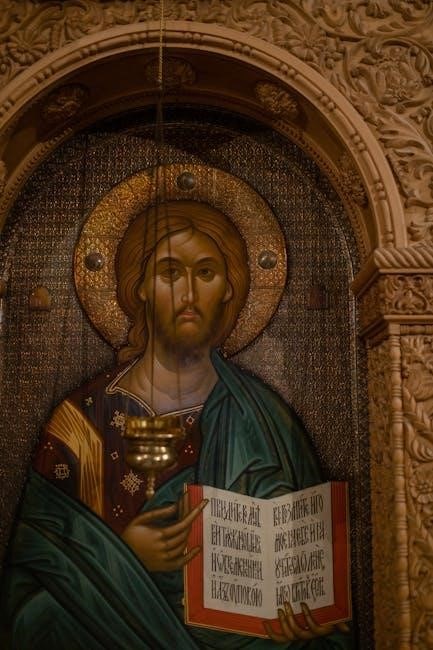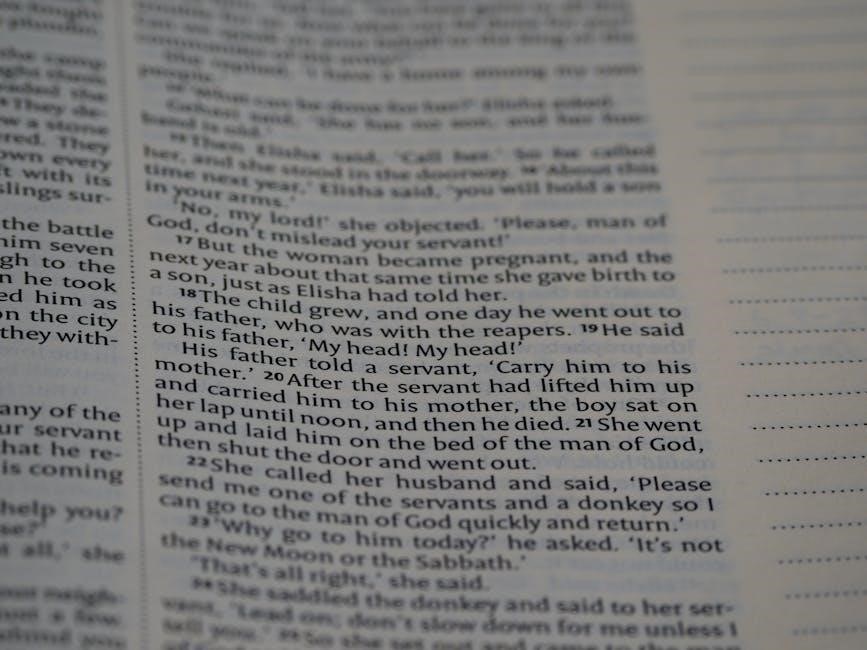The timeline of prophets and kings in the Bible spans from ancient Israel’s formation to the Babylonian Exile‚ detailing rulers and prophets who shaped Israel and Judah’s history. This period‚ from approximately 1050 BC to 400 BC‚ highlights key figures like Saul‚ David‚ and Solomon‚ as well as major prophets such as Elijah‚ Isaiah‚ and Jeremiah. The timeline provides a chronological framework for understanding political and spiritual leadership‚ offering insights into their roles‚ reigns‚ and divine interactions. It also explores the divided kingdoms‚ their eventual falls‚ and the prophetic messages during captivity. Modern resources‚ including PDF guides and series like Of Kings and Prophets‚ offer deeper exploration of these events.
Overview of the Biblical Timeline
The biblical timeline chronicling prophets and kings spans from the patriarchal era of Abraham to the birth of Jesus‚ providing a comprehensive framework of Israel’s history. It begins with the United Monarchy under Saul‚ David‚ and Solomon‚ highlighting their significant roles in shaping Israel’s identity. Following Solomon’s reign‚ the kingdom divides into Israel (Northern Kingdom) and Judah (Southern Kingdom)‚ each ruled by various kings whose actions are judged as good or evil. The timeline marks pivotal events like the fall of Samaria in 722 BC and Jerusalem in 586 BC‚ leading to the Assyrian and Babylonian captivities. Prophets such as Elijah‚ Elisha‚ Isaiah‚ and Jeremiah play crucial roles‚ delivering divine messages and calling for repentance. This timeline also includes resources like PDF charts summarizing kings’ reigns and modern adaptations‚ such as the TV series Of Kings and Prophets‚ which dramatizes these biblical accounts for contemporary audiences.
Importance of Understanding Prophets and Kings
Understanding the prophets and kings of the Bible provides deep insights into Israel’s spiritual and political journey‚ revealing God’s plan and human responses. These figures‚ both flawed and faithful‚ illustrate divine interactions‚ moral lessons‚ and the consequences of obedience or rebellion. Prophets like Elijah‚ Isaiah‚ and Jeremiah delivered critical messages‚ calling Israel to repentance and faith‚ while kings such as David and Solomon exemplified leadership‚ wisdom‚ and the challenges of power. Studying their roles helps believers grasp biblical themes of redemption‚ justice‚ and covenant faithfulness. Additionally‚ modern resources like PDF timelines and adaptations such as the TV series Of Kings and Prophets make these ancient stories accessible‚ bridging the gap between history and contemporary relevance‚ offering timeless lessons for personal and communal faith.
Structure of the Timeline
The timeline of prophets and kings in the Bible is organized chronologically‚ spanning from the United Monarchy under Saul‚ David‚ and Solomon to the Divided Kingdom of Israel and Judah. It highlights key events‚ such as the establishment of the monarchy‚ the division of the kingdom‚ and the eventual falls of Samaria and Jerusalem. The timeline also integrates the roles of prophets like Elijah‚ Elisha‚ Isaiah‚ and Jeremiah‚ who played crucial roles during periods of political and spiritual upheaval. Modern resources‚ including PDF guides and series like Of Kings and Prophets‚ present this timeline in accessible formats‚ helping readers connect historical events with prophetic messages. This structured approach provides a clear framework for understanding the interplay between leadership‚ prophecy‚ and divine purpose throughout Israel’s history.

The United Monarchy (1050 BC – 930 BC)
The United Monarchy period‚ spanning 1050 BC to 930 BC‚ saw the rise of Kings Saul‚ David‚ and Solomon‚ who unified Israel under a single rule‚ transitioning from tribal leaders to a centralized monarchy. This era marked the establishment of Jerusalem as the capital and the construction of the Temple‚ solidifying Israel’s religious and political identity. The reigns of these kings laid the foundation for Israel’s golden age and the subsequent division into two kingdoms‚ setting the stage for the prophetic narratives that would follow.
Saul: The First King of Israel
Saul‚ the first king of Israel‚ ruled from approximately 1050 BC to 1010 BC. His reign marked the transition from a tribal federation to a centralized monarchy. Chosen by God through the prophet Samuel‚ Saul initially demonstrated humility and bravery‚ leading Israel to victory against the Ammonites. However‚ his reign was marred by disobedience and impulsive decisions‚ such as sparing King Agag and the best of the Amalekites’ livestock‚ contrary to God’s command. This led to Samuel anointing David as the future king. Saul’s jealousy of David’s rise and divine favor plunged him into mental turmoil and violent behavior‚ ultimately resulting in his downfall. His reign ended tragically at the Battle of Mount Gilboa‚ where he fell to the Philistines. Despite his failures‚ Saul’s story highlights the complexities of leadership and divine sovereignty.
David: The Ideal King
David‚ who ruled Israel from approximately 1010 BC to 970 BC‚ is often regarded as the ideal king in the Biblical narrative. A skilled warrior and leader‚ David unified the tribes of Israel and established Jerusalem as the capital. His reign is marked by military victories‚ including the defeat of Goliath‚ and the retrieval of the Ark of the Covenant‚ symbolizing God’s presence among His people. David’s covenant with God‚ as recorded in 2 Samuel 7‚ promised an eternal dynasty‚ foreshadowing the Messiah. Despite his flaws‚ such as his sin with Bathsheba‚ David’s repentance and devotion to God set him apart. His leadership combined faith‚ wisdom‚ and humility‚ making him a model for future kings. David’s legacy as a “man after God’s own heart” endures‚ shaping Israel’s identity and Messianic hopes.
Solomon: Wisdom and Division
Solomon‚ who ruled Israel from around 970 BC to 930 BC‚ is celebrated for his wisdom‚ granted by God in a dream at Gibeon. His reign marked a golden age of prosperity and peace‚ during which he built the Temple in Jerusalem‚ a central place of worship. Solomon’s wisdom is famously depicted in his just judgment between two women claiming the same child. However‚ his later life was marred by idolatry‚ influenced by his many foreign wives‚ leading to God’s displeasure. Upon his death‚ the kingdom split into the Northern Kingdom (Israel) and the Southern Kingdom (Judah)‚ fulfilling the prophecy of division due to Solomon’s sins. His legacy is a mix of divine favor and human failure‚ highlighting the consequences of turning away from God.

The Divided Kingdom (930 BC – 586 BC)
After Solomon‚ Israel divided into the northern kingdom of Israel and southern Judah. Both experienced cycles of faithfulness and rebellion‚ culminating in their falls to Assyria (722 BC) and Babylon (586 BC).
Kings of Israel (Northern Kingdom)
The northern kingdom of Israel‚ established after the division‚ had 19 kings across nine dynasties‚ reflecting its political instability. Jeroboam I‚ its first king‚ introduced idolatrous practices‚ setting a pattern of rebellion against God. Many kings faced violent ends‚ with coups and assassinations common. Notable rulers included Baasha‚ who overthrew Nadab‚ and Jehu‚ who seized power after condemning Ahab’s dynasty. Despite occasional righteous acts‚ most kings embraced idolatry‚ leading to widespread sin. Spiritual leaders like Elijah and Elisha called the people to repentance‚ but their efforts were often met with resistance. The northern kingdom’s history is marked by cycles of sin‚ judgment‚ and fleeting repentance‚ ultimately contributing to its downfall. This period highlights the consequences of rejecting divine authority and the enduring need for covenant faithfulness.
Kings of Judah (Southern Kingdom)
The southern kingdom of Judah‚ with Jerusalem as its capital‚ endured from 930 BC to 586 BC. Its 20 kings‚ though often flawed‚ included some who upheld faithfulness to God. Rehoboam‚ the first king‚ faced immediate challenges‚ while Asa and Jehoshaphat implemented reforms. Uzziah strengthened Judah’s military‚ but his pride led to downfall. Hezekiah‚ a righteous king‚ trusted God during Assyria’s siege‚ and Manasseh repented after captivity. Josiah restored worship‚ discovering the Law. Despite these efforts‚ many kings embraced idolatry‚ mirroring Israel’s failures. Prophets like Isaiah and Jeremiah urged repentance‚ warning of judgment. Judah’s history reflects cycles of faithfulness and rebellion‚ ending in exile under Babylon. The southern kingdom’s legacy emphasizes the importance of covenant loyalty and divine mercy‚ even amid human frailty.
Key Prophets of the Divided Kingdom
During the Divided Kingdom period‚ prophets played a pivotal role in guiding both Israel and Judah. In the Northern Kingdom‚ prophets like Amos and Hosea emphasized justice and faithfulness‚ urging the people to return to God. Amos condemned social inequality‚ while Hosea symbolized God’s love through his marriage. In the Southern Kingdom‚ Micah and Isaiah called for repentance‚ warning of impending judgment. Isaiah‚ in particular‚ highlighted the coming Messiah and the restoration of Israel. These prophets served as moral and spiritual guides‚ often clashing with corrupt kings. Their messages of judgment and hope were central to preserving the covenant and preparing the people for future redemption. Their teachings remain foundational in understanding the spiritual struggles and eventual exile of both kingdoms.

Major Prophets and Their Roles
Major prophets like Isaiah‚ Jeremiah‚ Ezekiel‚ and Daniel played crucial roles in guiding Israel through critical periods‚ emphasizing repentance‚ judgment‚ and future restoration‚ shaping biblical history.
Elijah and Elisha: Prophets of Israel

Elijah and Elisha were prominent prophets in the Northern Kingdom of Israel‚ serving during a time of intense spiritual decline. Elijah‚ known for his bold confrontation of King Ahab and Queen Jezebel‚ stood against the worship of Baal‚ culminating in the dramatic showdown on Mount Carmel. His miracles‚ including raising a widow’s son and calling fire from heaven‚ showcased God’s power. Elisha‚ Elijah’s successor‚ received a double portion of his spirit and performed numerous miracles‚ such as healing the waters of Jericho and Naaman the leper. Both prophets emphasized repentance and loyalty to Yahweh‚ while also demonstrating compassion and divine authority. Their ministries underscored God’s active involvement in Israel’s history‚ even amidst widespread disobedience.
Isaiah: Prophet of Judah
Isaiah‚ a prominent prophet in Judah during the 8th century BC‚ is renowned for his profound prophecies and poetic writings. Active during the reigns of Kings Uzziah‚ Jotham‚ Ahaz‚ and Hezekiah‚ Isaiah witnessed significant political and spiritual challenges‚ including the Assyrian threat. His ministry emphasized repentance‚ trust in God‚ and the condemnation of idolatry. Isaiah’s prophecies are divided into judgment and hope‚ foreseeing both the fall of Judah and the eventual restoration of Israel. He is famous for his Messianic prophecies‚ such as the virgin birth in Isaiah 7:14 and visions of a redeemed future. His teachings stress justice‚ righteousness‚ and the sovereignty of God. Isaiah’s legacy endures as a central figure in biblical prophecy‚ offering both warning and comfort to his people. His writings remain foundational for understanding God’s plan of redemption and the ultimate hope of Israel’s restoration.
Jeremiah: Prophet of Judgment
Jeremiah‚ a prophet of the 7th and 6th centuries BC‚ is known as the “Prophet of Judgment” for his dire warnings to Judah. He ministered during the reigns of Kings Josiah‚ Jehoahaz‚ Jehoiakim‚ and Zedekiah‚ a period marked by spiritual decay and political turmoil. Jeremiah’s messages emphasized repentance‚ calling the people to turn from idolatry and social injustice. He prophesied the fall of Jerusalem and the Babylonian exile‚ which occurred in 586 BC. His prophecies were often met with resistance‚ leading to personal persecution. Despite the judgment‚ Jeremiah also offered hope‚ foreseeing a future restoration and a new covenant. His emotional depth‚ captured in the Book of Lamentations‚ reflects his sorrow over Judah’s fate. Jeremiah’s ministry underscores God’s justice and mercy‚ making him a pivotal figure in the biblical narrative of judgment and redemption.

The Fall of Samaria and the Assyrian Captivity
In 722 BC‚ Samaria fell to the Assyrians under Shalmaneser V‚ leading to the Assyrian Captivity. Israel’s northern kingdom was dissolved‚ and its people were deported.
The Fall of Samaria in 722 BC
The fall of Samaria in 722 BC marked the end of the northern kingdom of Israel. The Assyrian Empire‚ under King Shalmaneser V‚ besieged the capital city after a three-year siege. The city’s defenses were breached‚ and it was captured. The Israelites were deported to various parts of the Assyrian Empire‚ leading to the “Lost Tribes of Israel.” This event was a fulfillment of prophetic warnings by prophets like Hosea and Amos‚ who called for repentance due to Israel’s idolatry and social injustice. The fall of Samaria signified the end of the northern kingdom’s independence and its absorption into the Assyrian Empire. This period is crucial in the timeline of prophets and kings‚ as it highlights the consequences of disobedience and the transition of power in the region.
The Assyrian Captivity and Its Impact
The Assyrian Captivity‚ following the fall of Samaria in 722 BC‚ led to the deportation of many Israelites to Assyria and Media. This period marked the end of the northern kingdom’s political existence. The captives were assimilated into Assyrian culture‚ losing their distinct identity over time. This dispersion contributed to the legend of the “Lost Tribes of Israel.” The captivity was seen as a divine judgment for Israel’s persistent idolatry and disregard for covenant obligations. Prophets like Hosea and Amos had warned of this consequence. The Assyrian Captivity reshaped the religious and cultural landscape of the region‚ leaving a lasting impact on the Israelites’ sense of identity and faith. It remains a pivotal event in the timeline of prophets and kings‚ illustrating the interplay of sin‚ judgment‚ and redemption.

The Babylonian Exile and Restoration

The Babylonian Exile (586–538 BC) followed Jerusalem’s fall. Judeans were deported to Babylon‚ leading to spiritual reflection and prophetic messages. Restoration began under Persian rule‚ rebuilding Jerusalem and the Temple.
The Fall of Jerusalem in 586 BC
In 586 BC‚ Jerusalem fell to the Babylonian Empire under King Nebuchadnezzar II‚ marking a pivotal moment in biblical history. The city was besieged‚ its walls breached‚ and the First Temple destroyed. Many Judeans were exiled to Babylon‚ while others remained in the land. This event fulfilled earlier prophetic warnings about judgment for Israel’s disobedience. The fall symbolized the end of the Davidic monarchy and the loss of national sovereignty. It also marked the beginning of the Babylonian Exile‚ a period of spiritual reflection and redefinition for the Jewish people. The destruction of the Temple‚ a central symbol of worship‚ deeply impacted Jewish identity and religious practices. This event is well-documented in historical records and biblical accounts‚ such as 2 Kings and Jeremiah‚ providing a rich source for understanding its significance in the timeline of prophets and kings.
Prophets During the Exile: Ezekiel and Daniel
Ezekiel and Daniel were prominent prophets who ministered during the Babylonian Exile‚ offering spiritual guidance and hope to the displaced Israelites. Ezekiel‚ a priest-turned-prophet‚ received dramatic visions‚ such as the valley of dry bones‚ symbolizing Israel’s future restoration. His prophecies emphasized divine judgment and the promise of renewal. Daniel‚ known for his wisdom and interpretive gifts‚ served in the Babylonian court‚ interpreting dreams and visions that foretold the rise and fall of empires. His apocalyptic visions‚ including the 70-week prophecy‚ provided a timeline for Israel’s redemption. Both prophets called the exiles to remain faithful‚ trusting in God’s ultimate plan to restore them to their homeland. Their ministries bridged the gap between judgment and hope‚ shaping the theological understanding of the exilic period.
The Restoration of Judah
The restoration of Judah occurred after the Babylonian Exile‚ marking a pivotal moment in Israel’s history. Following Cyrus the Great’s decree in 538 BC‚ the Jews were allowed to return to Jerusalem. Zerubbabel‚ a descendant of David‚ led the initial wave of returnees and oversaw the rebuilding of the Temple‚ completed in 516 BC. Despite challenges‚ including opposition from Samaritan neighbors‚ the Judeans gradually reestablished their community. The restoration period also saw spiritual renewal‚ as Ezra and Nehemiah played key roles in reforming worship and rebuilding Jerusalem’s walls. This era laid the foundation for the Second Temple period‚ revitalizing Jewish identity and setting the stage for future messianic hopes.

Modern Adaptations and Resources
Modern adaptations include study guides‚ interactive timelines‚ and eBooks that explore the lives of prophets and kings. Visual aids like charts and infographics simplify complex histories‚ while online courses and apps offer deeper insights into biblical narratives.
The Bible-Based Series “Of Kings and Prophets”
The series “Of Kings and Prophets” is a historical drama inspired by biblical narratives‚ focusing on the lives of key figures such as Saul‚ David‚ and Solomon. It explores their triumphs‚ struggles‚ and spiritual journeys‚ aligning with the timeline of prophets and kings in the Bible. The show highlights the complexities of leadership‚ faith‚ and divine purpose‚ offering a visual representation of events described in the Old Testament.
The series also delves into the roles of prophets like Samuel and Nathan‚ who played crucial roles in guiding the kings. By dramatizing these stories‚ it provides a compelling way to engage with biblical history. While it takes creative liberties‚ the series remains faithful to the spiritual core of the original accounts‚ making it a valuable resource for those interested in the timeline of prophets and kings.
PDF Resources for Further Study

For deeper exploration‚ numerous PDF resources are available‚ offering detailed timelines and analyses of biblical prophets and kings. These documents provide chronological charts‚ historical context‚ and theological insights‚ aiding in understanding the intricate relationships between rulers and prophets. Many resources are designed for educational purposes‚ catering to scholars‚ students‚ and enthusiasts alike.
Popular PDFs include comprehensive study guides‚ such as “The Timeline of Prophets and Kings in the Bible‚” which outlines key events and figures. Others‚ like “Biblical Kingship and Prophecy‚” delve into the theological significance of these leaders. These resources are often available on religious websites‚ academic platforms‚ and online libraries‚ making them accessible for further study and reference.


